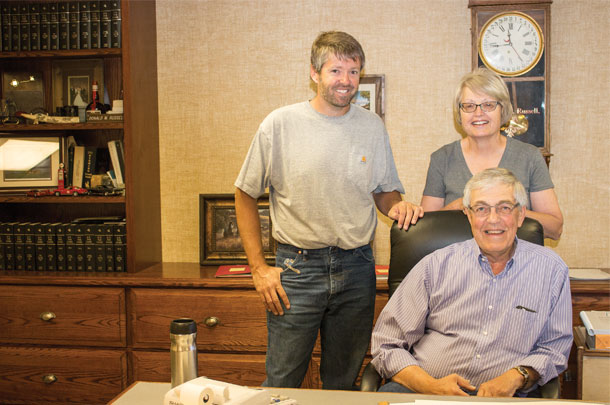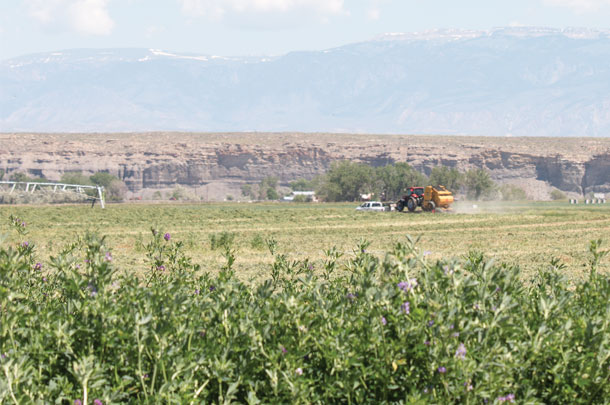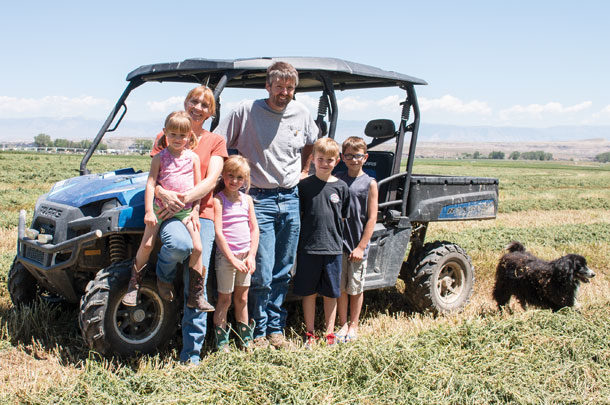According to the most recent Wyoming agriculture statistics, which is the 2014 edition that highlights the 2013 production year, Wyoming’s number one agronomic crop in terms of value is forage production ($390 million).
As crop and forage program manager for the Wyoming Business Council Donn Randall says, “As a result of managing the Wyoming State Fair Open Hay Show, I get to represent our Wyoming forage producers back at the World Dairy Expo each year by entering the five best Wyoming alfalfa and mixed-grass samples in the World Forage Analysis Superbowl."
"I will not try to brag too much here, but as a result, I have yet to have the commercial forage winner not be from Wyoming for the past seven years. We have also placed, on average, four or five of our alfalfa samples in the top six places in the commercial alfalfa forage division over the same time period.”
That’s quite a record, and that’s the front story. Now for the back story of one Wyoming hay producer.
You’ve heard the tale: A farm kid goes off to college and stays in the city. Richard Russell’s story certainly started out that way.
Although years ago Richard Russell was an American Star Farmer in FFA in Basin, Wyoming, he didn’t intend to end up on the family farm or in the hay business; his brother, Bill, was the “real farmer.” So Russell went to college, majoring in accounting, before deciding to continue with law school and specializing in tax law. That was the plan, at least.
Then Russell visited his parents (Don and Cheri Russell) one weekend on the family farm, and when he drove out of the yard to return to college, Bill was changing the duals on a tractor. While changing duals may seem mundane and even unpleasant to most folks, Russell’s only thought was, “He’s the lucky one.”
He knew if he pursued tax law he’d have to live in a larger metropolis than Basin, Wyoming, and that’s when he realized he wanted to return to his roots.

Russell quit law school, joined his father’s accounting firm in Basin (Russell & Russell CPA) and helped on the family farm when he could. Then seven years ago, the Russell family was turned upside-down when Bill was killed in a car accident.
Russell says the community really rallied and helped the family get through that first farming season, but he quickly realized he’d need to put far more effort into the farm going forward than he had previously.
The original family farm started with 160 acres and slowly expanded to about 1,000 acres of sugar beets, malt barley, alfalfa, orchardgrass-smooth brome mixed hay and irrigated pasture. As it grew, changes were needed to increase efficiency.
Russell says the Basin area has been slower to adopt pivot irrigation than many areas of the West, but he now has 60 percent of the farm under pivot. “Our yield is up, inputs are down, and efficiency is up,” under the pivots, he says.
Russell also converted to the use of GPS systems. He says the GPS on the swather and tractor creates more consistency, fewer slugs and better efficiency. His next plan is to incorporate electrical conductivity soil mapping to increase productivity and better manage inputs.
Russell works with a hay broker to sell hay to horse farms in Texas in 4-by-4 and 3-by-3 bales. With this arrangement, they are able to sell hay all year long. He appreciates working with a broker and says, “If you try to chase the high hay prices, you’ll only buy high and sell low. It’s better to be consistent with pricing.”
Last year they built a hay shed, which paid itself off in the first year. Russell says, “Before a guy buys a new baler or swather, he should put up a barn. Even if it’s not horse hay or might be for the beef market, I’d still put up the storage first. Everybody likes green hay and one rainstorm can streak the stack.”
Russell sells the first cutting almost the minute it comes out of the field, and the second and third cuttings are put under the shed until it sells. If hay is rained on in the field or otherwise compromised, Russell feeds it to his beef cows, saying, “Cows really help with the hay business.” His 60 cows use grazing permits on Bureau of Land Management lands for summer feed.
As an accountant, Russell sees the changes that have come to farming from a little different perspective. Russell says, “It used to be that farms were indebted to maybe a million dollars. Now, with a tractor costing a quarter-million and a baler costing another quarter-million, it’s not unusual for farms to be indebted several million.”
Russell also notes that when he started farming, their 1,000 acres would have been a reasonably good-sized farm in the West, but today “it’s almost a hobby farm.” He also noted that several of the smaller farmers are no longer in business, and says, “We contract sugar beets, and it used to be at the beet dump there would be 70 trucks lined up, but anymore there are maybe 15.”
There are disadvantages to being both a certified public accountant and a farmer. Russell says, “Sometimes I overanalyze things.” He also says the overlap of tax preparation season with calving season meant burning the candle at both ends until they pushed back calving to mid-March.
Russell spends half his time now as a farmer, with his wife, Cassie, and children Catcher, Granger, Charlie and Cali contributing, and an indispensable hired man, Delton Ense. Russell is quick to admit that Ense is very capable and takes care of most of the farming. In addition, Cassie, Don and Cheri are instrumental in keeping the farm together. It’s a whole-family effort.

Russell hosted the equipment demonstrations as part of the Wyoming Forage Field Day held last spring, sponsored by the Wyoming Business Council in cooperation with University of Wyoming Ag Extension forage specialist Dr. Anowar Islam.
Randall says the event was established in 2011 as an educational service to Wyoming hay producers as a means of promoting the quality of Wyoming hay and also encouraging more producers to grow a higher-quality hay that could be exported out-of-state to some of the niche markets.
Randall says conditions for hay production in Wyoming are advantageous with low humidity, cool nights and not a lot of rain, which means that due to irrigation, producers control watering, at least to some extent.
“Although we may not get as many cuttings to sell, pound-for-pound, Wyoming hay is higher in TDN (total digestible nutrients) and thus the animals that receive Wyoming hay get more nutrients per pound and thus do not have to eat as much to get their daily requirements,” Randall says.
Randall says he sees three very different groups of Wyoming forage producers: cow-calf producers who round-bale all of their hay and may not be as concerned with quality as they are quantity, depending on sub-irrigated fields to grow native grasses; producers with diversified operations – crop and livestock –who may sell some of their hay or just feed it to their livestock; and the hay producers who are the leaders in producing high-quality hay.
Randall says, “The third group includes producers like Ervan Gara – Torrington, David Hiniman – Wheatland, Kim Brown – Farson, Erik Gormley – Burlington, Bryan Warner – Riverton, and Richard Russell – Basin.
These producers are very much in touch with their customers; they know the market and the quality that their customers need and want, and have developed sound production practices to consistently produce a very high-quality product year-in and year-out.”
Randall notes the producers named all have a successful livestock enterprise as well, and says, “By having livestock to feed, these producers can then feed the off-quality hay to their livestock and then only send the very best hay to their customers.” FG
Click here to watch a video on hay production in Wyoming.
PHOTO 1: Cassie and Richard Russell make haying a family affair with their children, Charlie, Cali, Catcher and Granger.
PHOTO 2: The Russell family hosted equipment demonstrations at the Wyoming Forage Field Day in the fossil-rich Bighorn Basin.
PHOTO 3: Richard, Cheri and Don Russell not only farm together, but also work together in their CPA firm in Basin, Wyoming. Photos courtesy of Lynn Jaynes.











